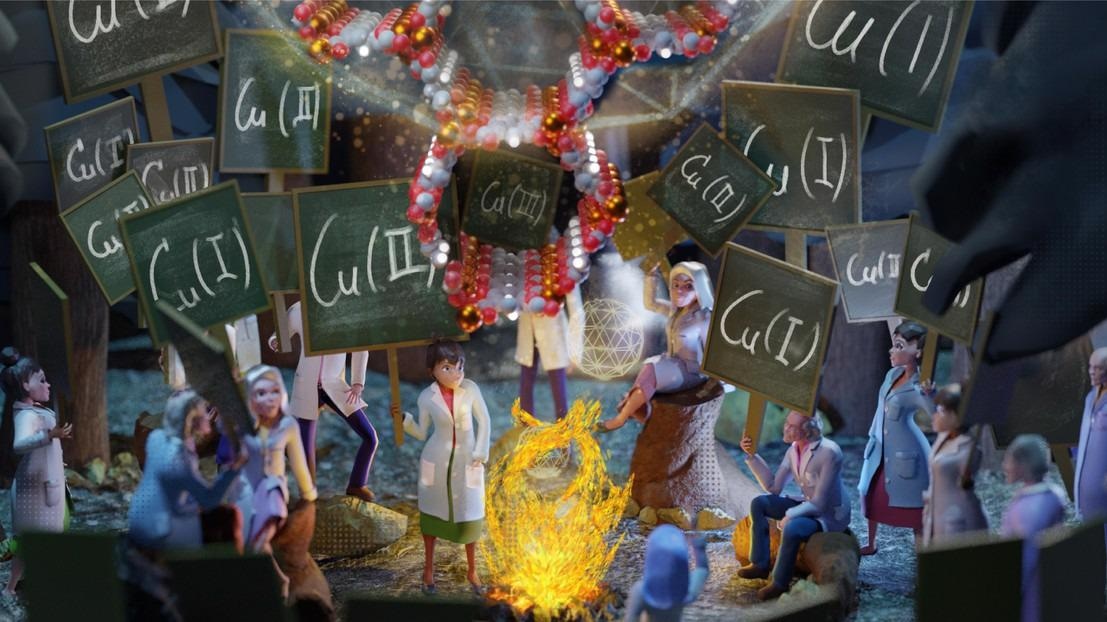A new machine-learning model developed by the chemical engineers of École polytechnique fédérale de Lausanne (EPFL) can help estimate the oxidation state of a compound, a property considered so vital that many chemists debate it should be included in the periodic table.
 Chemists voting on the oxidation states of metal-organic frameworks. Image Credit: David Abbasi Pérez.
Chemists voting on the oxidation states of metal-organic frameworks. Image Credit: David Abbasi Pérez.
Almost everything in the physical world is made of chemical elements. As of 2016, 118 elements are known, all of which are categorized in the famous periodic table found in every classroom and chemistry lab.
Every element in the periodic table seems like a one-, two-letter abbreviation (for example, Al for aluminum, O for oxygen) together with its atomic number, which displays how many protons are there in the nucleus of the element.
The number of protons present is greatly significant, as it also governs the number of electrons that orbit the nucleus, which typically makes the element what it is and provides it its chemical properties. The atomic number is the ID card of an element.
The Periodic Table Should Include Oxidation States
Chemical engineers at EPFL’s School of Basic Sciences analyzed another number that should be reported for every element in the periodic table: the oxidation state of the element, also called oxidation number. The study was published in the Nature Chemistry journal.
In other words, the oxidation state indicates the number of electrons that must be gained or lost by an atom to develop a chemical bond with another atom.
In chemistry, the oxidation state is always reported in the chemical name of a compound. Oxidation states play such an important role in the fundamentals of chemistry that some have argued that they should be represented as the third dimension of the periodic table.
Berend Smit, Study Lead and Professor, EPFL
The best example is chromium: in oxidation state III, it is vital to the human body; in oxidation state IV, it is extremely poisonous.
Complex Materials Complicate Things
However, despite that deciphering the oxidation state of a single element is easy, in the case of compounds composed of multiple elements, things turn out to be difficult.
Smit said, “For complex materials, it is in practice impossible to predict the oxidation state from first principles. In fact, most quantum programs require the oxidation state of the metal as input.”
Yet, the existing advancement in forecasting oxidation states is based on something known as “bond valence theory” developed in the early 20th century, which helps evaluate the oxidation state of a compound depending on the distances between the atoms of its constituent elements. However, this does not always hold, particularly in materials with crystal structures.
“It is well known that it is not only the distance that matters but also the geometry of a metal complex. But attempts to take this into account have not been very successful,” stated Smit.
A Machine-Learning Solution
As part of the study, the scientists could train a machine-learning algorithm to categorize a popular group of materials, the metal-organic frameworks, by oxidation state.
The researchers made use of the Cambridge structural database, a repository of crystal structures in which the oxidation state is provided in the name of the materials.
Smit stated, “The database is very messy, with many errors and a mixture of experiments, expert guesses, and different variations of the bond valence theory are used to assign oxidation states. We assume that chemistry is self-correcting. So while there are many errors on individual accounts, the community as a whole will get it right.”
We basically made a machine-learning model that has captured the collective knowledge of the chemistry community. Our machine learning is nothing more than the television game.
Kevin Jablonka, PhD Student in Smit’s Group, EPFL
Jablonka added, “‘Who Wants To Be A Millionaire?’ If a chemist does not know the oxidation state, one of the lifelines is to ask the audience of chemistry what they think the oxidation state should be. By uploading a crystal structure and our machine-learned model is the audience of chemists that will tell them what the most likely oxidation state is.”
The study was financially supported by the European Research Council (ERC), the Swiss National Science Foundation (SNSF), and NCCR-MARVEL.
Journal Reference:
Jablonka, K. M., et al. (2021) Using collective knowledge to assign oxidation states of metal cations in metal–organic frameworks. Nature Chemistry. doi.org/10.1038/s41557-021-00717-y.